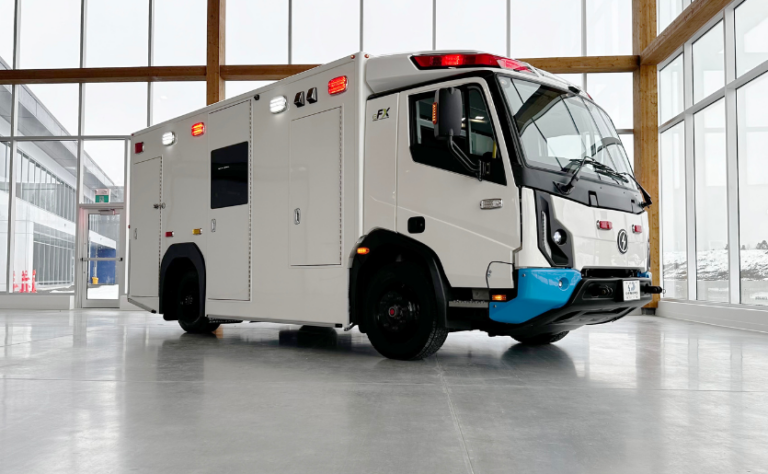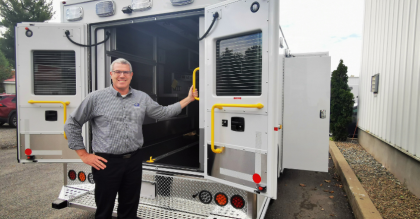Taking the leap towards an electric ambulance in the realm of emergency is a big decision – this is why as a first step it’s crucial to perform an initial qualification evaluation.
Our innovation engineers and experts from the Insitut du Véhicule Innovant (IVI) have created an easy-to-use tool that will allow your representative to determine if the eFX is a good fit for your ambulance service needs, as well as make sure you have the right tools in place that will maximize the success of the deployment of your electric ambulance.
If your organization meets the criteria for the purchase of the eFX, Demers Ambulances will support you in your electrification process for a successful deployment.
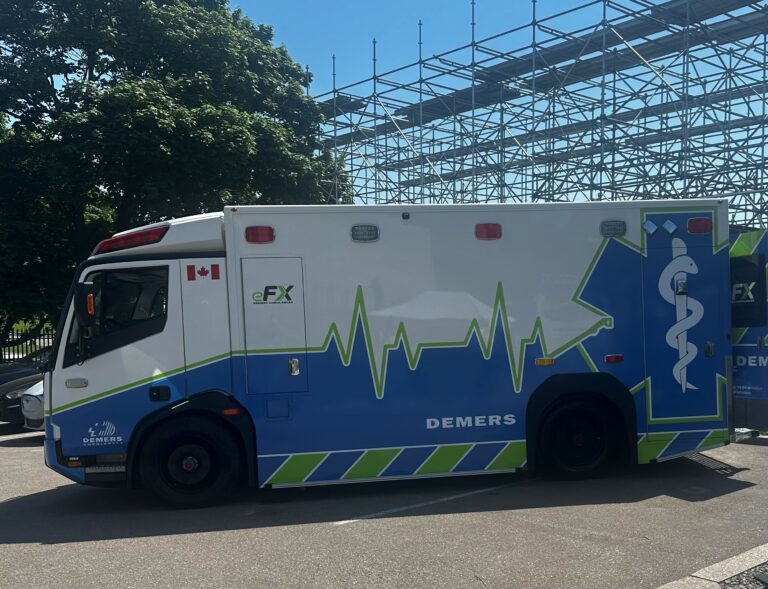
A Thorough Analysis of Your Current Reality
At Demers, our mission has always been to help paramedics save lives by providing safe, reliable vehicles. With nearly 65 years of expertise in ambulance manufacturing, our top priority remains delivering vehicles that meet our clients’ needs, supporting them in their life-saving work.
If Demers offers an electric ambulance to a customer, it is because a preliminary analysis has first been completed using the simulator and the result demonstrates that the eFX is a good solution for its specific use case. The evaluation process prioritizes the operational and infrastructure so that EMS providers benefit from the use of an electric ambulance, and so will their patients.
Transitioning to an electric emergency vehicle takes a lot of planning and support, and it’s important to be prepared to tackle this change management from every angle. The pre-qualification stage is a crucial first step before diving in headfirst.
So, what factors does the Demers team consider when evaluating the suitability of an electric ambulance for a particular service?
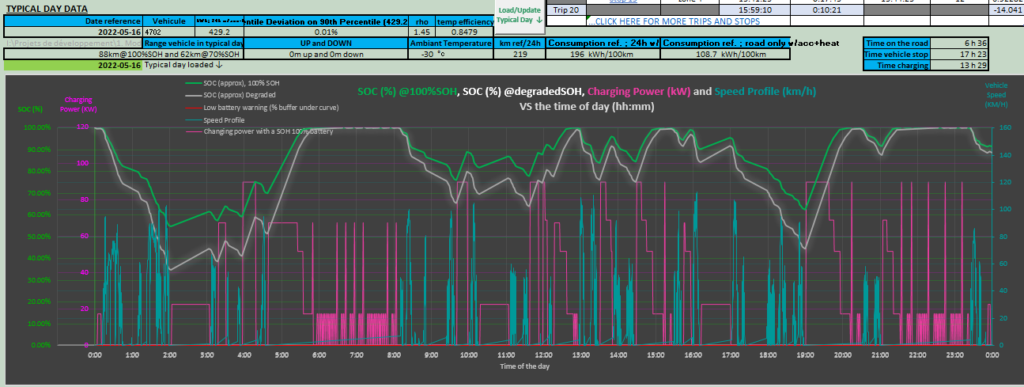
The three main factors that are analysed using the compatibility report are:
The Life Cycle Emissions, the Total Cost of Ownership and Range Compatibility.
These key components will determine if the eFX ambulance is compatible with your operating conditions. To determine the life cycle emissions, range compatibility and total cost of ownership, there is specific criteria that is analysed based on your answers before making a proper assessment of your fleet needs.
Average trip duration from patient home to the hospital
A very important aspect that we analyse is the average trip duration between the patient home and the hospital. The compatibility report considers real-life scenarios and the range requirements for the needs of your fleet during emergency response missions.
Area of operation
Our tool takes into account greenhouse gas (GHG) emissions emitted by the electricity supplier. For example, if the customer says they are located in Alabama, the tool will look for the number of tonnes of CO2 emitted per kWh of electricity produced. This will be considered in the calculation of the reduction of GHG emissions of an electric ambulance compared to a conventional ambulance.
Charging Schedule Availability
The ability to charge the vehicle throughout the day is an important issue to take into account. If charging stations are available where the vehicle will be parked during the day, the chances increase that the deployment will be a success. An ambulance whose charging infrastructure has been well thought out in advance greatly increases the mobility of the vehicle, even in the worst conditions. The tool takes into account the availability of chargers during the day to evaluate the vehicle’s range.
Typical cold temperature
Low temperatures impact the autonomy and range of the eFX, just like any other electric vehicle. Therefore, climate conditions are evaluated during the assessment to determine if they significantly influence the eFX‘s performance.
Electricity rate
Evaluating the electricity rate is crucial for assessing the cost-effectiveness of charging electric ambulances compared to traditional fuel sources. This analysis provides valuable insights to help make informed financial decisions regarding your fleet operations. The compatibility tool compares the costs associated with electricity consumption for the eFX against the expenses of conventional gasoline or diesel. This analysis will shine a line on whether or not there are potential savings and long-term economic benefits compared to a traditional combustion engine.
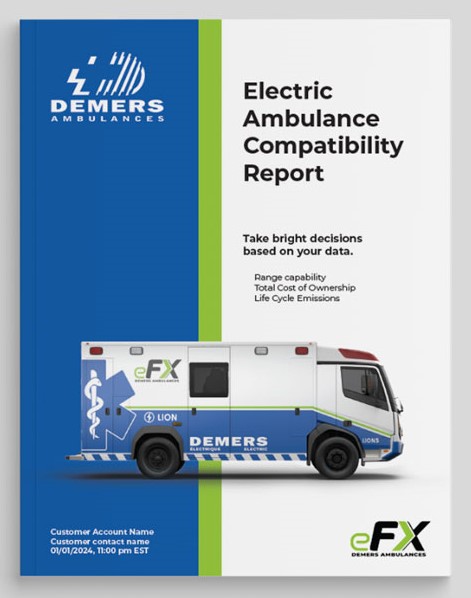
Annual mileage per ambulance
Estimating the annual mileage per ambulance is essential for making accurate projections of operating costs when transitioning to an electric ambulance. This field asks for the typical distance your ambulance covers in a year on average. The comparator adjusts gas prices according to your area of operation.
Average fuel consumption per ambulance per fleet and price of fuel
Analyzing the average fuel consumption per ambulance within a fleet is critical for comparing the benefits of an electric ambulance to their conventional counterparts. This comparison provides fleet managers with a clear understanding of the potential savings in fuel costs, highlighting the economic benefits of switching to EVs. In additional, the fuel price is also taken into account. Depending on the location, the fuel price will affect the total cost savings by switching to an electric ambulance.
These factors, among others, form the basis of the comprehensive evaluation process conducted by the Demers Ambulances team. By taking into account the unique operational challenges and requirements of ambulance services, Demers Ambulances ensures that customers receive tailored recommendations that align with their goals and priorities.
Furthermore, Demers Ambulances recognizes that the transition to an electric ambulance is not a one-size-fits-all solution. While EV ambulances offer numerous benefits, including reduced emissions, lower operating costs, and quieter operation, they may not be suitable for every service or environment. Therefore, the goal is not to push for widespread adoption indiscriminately but to support ambulance services in making informed decisions that best serve their needs and circumstances.
The Demers Ambulances team’s commitment to supporting ambulance services throughout the entire process of purchasing EV ambulances reflects their dedication to advancing safety, sustainability, and innovation in emergency medical services. By prioritizing functionality, reliability, and customer satisfaction above all else, Demers ensures that ambulance service providers can transition to an electric ambulance with confidence, knowing that they have a trusted partner by their side every step of the way.

